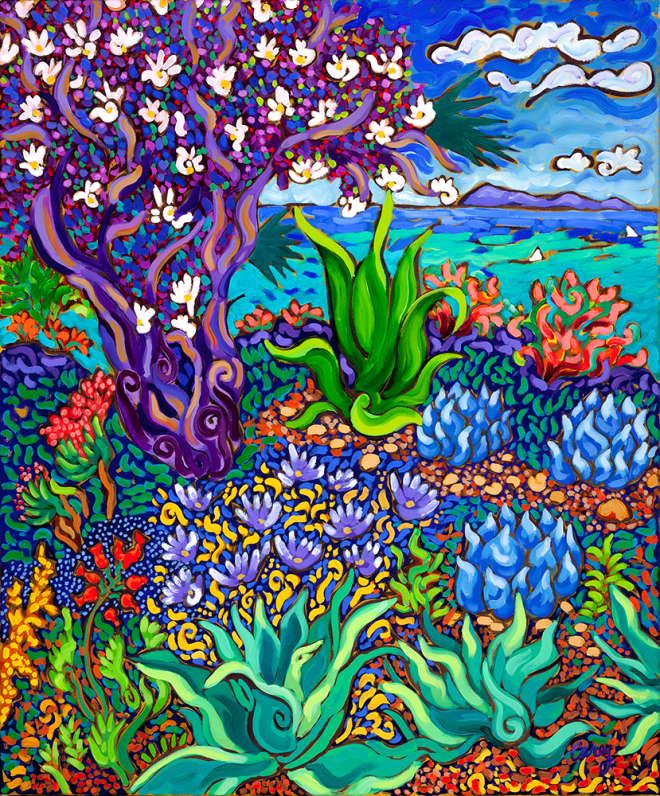Blog
Terrence Mitchell Riley (born June 24, 1935) is an American composer and performing musician best known as a pioneer of the minimalistschool of composition. Influenced by jazz and Indian classical music, his music became notable for its innovative use of repetition, tape musictechniques, and delay systems. He produced his best known works in the 1960s: the 1964 composition In C and the 1969 LP A Rainbow in Curved Air, both considered landmarks of minimalism and important influences on experimental, rock, and contemporary electronic music.[3]
Raised in California, Riley began studying composition and performing solo piano in the 1950s. He befriended and collaborated with composer La Monte Young, and later became involved with the San Francisco Tape Music Center. A two-record deal with CBS in the late 1960s, resulting in an LP recording of In C (1968) and A Rainbow in Curved Air (1969), brought his work to wider audiences. In the 1970s, he began intensive studies with Hindustani singer Pandit Pran Nath. He has collaborated frequently throughout his career, most extensively with chamber ensemble the Kronos Quartet and his son, guitarist Gyan Riley.
Born in Colfax, California in 1935, Riley began performing as a solo pianist during the 1950s. During that decade, he studied composition at San Francisco State University, the San Francisco Conservatory, and University of California, Berkeley, studying with Seymour Shifrin and Robert Erickson. He befriended composer La Monte Young, whose earliest minimalist compositions using sustained tones were an influence; together, Young and Riley performed Riley’s improvisatory composition Concert for Two Pianists and Tape Recorders in 1959–60.
more...Perched between the cascading arch of the Milky Way and the dark mountainside of La Silla Observatory lies the New Technology Telescope (NTT).
Since 1989 this ESO telescope has observed and taken images of our night sky in exquisite detail. Some of its more recent achievements include: the observation of the merging of two neutron stars; a more detailed insight into the structure of asteroids; the analysis of hundreds of planetary nebulae; and even research into planets in far off solar systems.
Telescopes with larger primary mirrors are able to capture more light. However, a larger mirror’s perfect shape is more difficult to maintain. Astronomers found that with primary mirrors over five metres in diameter, image quality decreased enormously as gravity pulled them out of shape (NTT is 3.5 meters in diameter and was meant as a pioneer project to allow telescopes with larger mirrors to be built). Active optics, an idea that came from ESO engineer Raymond Wilson, means that a thin and deformable primary mirror can be controlled by a primary support system that applies the necessary force to correct for these gravity-induced deformations.
The improvements to ground-based astronomy as a result of this new design were huge. Active optics became the main feature of the NTT, which has since viewed phenomena in the sky in exquisite detail. The telescope’s active optics were soon implemented on the two, segmented, 10-metre telescopes at Keck Observatory in Hawai‘i. The design of this telescope was revolutionary. Advancements are still being made today, implementing similar technology in some of the largest telescopes in the world.

Robert C. Christie Hunter (born Robert Burns, June 23, 1941 – September 23, 2019) was an American lyricist, singer-songwriter, translator, and poet, best known for his work with the Grateful Dead. Born near San Luis Obispo, California, Hunter spent some time in his childhood in foster homes, as a result of his father’s abandoning his family, and took refuge in reading and writing. He attended the University of Connecticut for a year before returning to Palo Alto, where he became friends with Jerry Garcia. Garcia and Hunter began a collaboration that lasted through the remainder of Garcia’s life.
Garcia and others formed the Grateful Dead in 1965, and some time later began working with lyrics that Hunter had written. Garcia invited him to join the band as a lyricist, and Hunter contributed substantially to many of their albums, beginning with Aoxomoxoa in 1969. Over the years Hunter wrote lyrics to a number of the band’s signature pieces, including “Dark Star“, “Ripple“, “Truckin’“, “China Cat Sunflower“, and “Terrapin Station“. Hunter was inducted into the Rock and Roll Hall of Fame with the Grateful Dead in 1994, and is the only non-performer to be inducted as a member of a band.Upon his death, Rolling Stone described him as “one of rock’s most ambitious and dazzling lyricists”.
Hunter was born Robert Burns on June 23, 1941 in Arroyo Grande, California, near San Luis Obispo.He was a great-great grandson of the Romantic poet Robert Burns, according to Charles Perry.[6] Hunter’s father was an alcoholic, who deserted the family when Hunter was seven, according to Grateful Dead chronicler Dennis McNally. Hunter spent the next few years in foster homes before returning to live with his mother. These experiences drove him to seek refuge in books, and he wrote a 50-page fairy tale before he was 11. His mother married again, to Norman Hunter, whose last name Robert took. The elder Hunter was a publisher, who gave Robert lessons in writing.
more...Sahib Shihab (born Edmund Gregory; June 23, 1925, Savannah, Georgia – October 24, 1989, Nashville, Tennessee) was an American jazz and hard bop saxophonist (baritone, alto, and soprano) and flautist. He variously worked with Luther Henderson, Thelonious Monk, Fletcher Henderson, Tadd Dameron, Dizzy Gillespie, Kenny Clarke, John Coltrane and Quincy Jones among others. Edmund Gregory first played alto saxophone professionally for Luther Henderson at age 13 and went on to study at the Boston Conservatory and to play with trumpeter Roy Eldridge. He played lead alto with Fletcher Henderson in the mid 1940s.
more...June Carter Cash (born Valerie June Carter; June 23, 1929 – May 15, 2003) was a five-time Grammy award-winning American singer, songwriter, actress, dancer, comedian, and author who was a member of the Carter Family and the second wife of singer Johnny Cash. Prior to her marriage to Cash, she was professionally known as June Carter and occasionally was still credited as such after her marriage (as well as on songwriting credits predating it). She played guitar, banjo, harmonica, and autoharp, and acted in several films and television shows. Carter Cash won five Grammy Awards and was inducted into the Christian Music Hall of Fame in 2009.
June Carter Cash was born Valerie June Carter in Maces Spring, Virginia, to Maybelle Carter and Ezra Carter. Her parents were country music performers and she performed with the Carter Family from the age of 10, in 1939. In March 1943, when the Carter Family trio stopped recording together at the end of the WBT contract, Maybelle Carter, with encouragement from her husband Ezra, formed “Mother Maybelle and the Carter Sisters” with her daughters, Helen, Anita, and June.
more...George Allen Russell (June 23, 1923 – July 27, 2009) was an American jazz pianist, composer, arranger and theorist. He is considered one of the first jazz musicians to contribute to general music theory with a theory of harmony based on jazz rather than European music, in his book Lydian Chromatic Concept of Tonal Organization (1953).
Russell was born in Cincinnati, Ohio to a white father and a black mother,[2] later the adopted only child of a nurse and a chef on the B & O Railroad, Bessie and Joseph Russell. Young Russell sang in the choir of the African Methodist Episcopal Church and listened to the Kentucky Riverboat music of Fate Marable. He made his stage debut at age seven, singing “Moon Over Miami” with Fats Waller.
more...Milton John Hinton (June 23, 1910 – December 19, 2000) was an American double bassist and photographer.[1]
Regarded as the Dean of American jazz bass players, his nicknames included “Sporty” from his years in Chicago, “Fump” from his time on the road with Cab Calloway, and “The Judge” from the 1950s and beyond. Hinton’s recording career lasted over 60 years, mostly in jazz but also with a variety of other genres as a prolific session musician.
He was also a photographer of note, praised for documenting American jazz during the 20th Century.
Hinton was born in Vicksburg, Mississippi, the only child of Hilda Gertrude Robinson, whom he referred to as “Titter,” and Milton Dixon Hinton. He was three-months-old when his father left the family. He grew up in a home with his mother, his maternal grandmother (whom he referred to as “Mama”), and two of his mother’s sisters.
more...How are jets created during star formation? No one is sure, although recent images of the young star system HD 163296 are quite illuminating. The central star in the featured image is still forming but seen already surrounded by a rotating disk and an outward moving jet. The disk is shown in radio waves taken by the Atacama Large Millimeter Array (ALMA) in Chile, and show gaps likely created by the gravity of very-young planets. The jet, shown in visible light taken by the Very Large Telescope (VLT, also in Chile), expels fast-moving gas — mostly hydrogen — from the disk center. The system spans hundreds of times the Earth-Sun distance (au). Details of these new observations are being interpreted to bolster conjectures that the jets are generated and shaped, at least in part, by magnetic fields in the rotating disk. Future observations of HD 163296 and other similar star-forming systems may help fill in details.

Ralph Molina (born June 22, 1943) is an American musician, best known as the drummer for Neil Young‘s backing band Crazy Horse.
Born in Puerto Rico, Molina has been a member of Crazy Horse since they were formed in 1962 as Danny & the Memories. He has remained throughout the band’s many personnel changes, and has performed on all releases by the band, with and without Young. Molina’s style of drumming is characterized by simple but steady beats and fills.
Molina’s musical beginnings were in local doo-wop groups, singing harmonies with friends in New York, and then in Florida, where he graduated high school. He later moved to California to sing with his cousin Lou’s group, which led to other musical opportunities. Molina joined Danny Whitten and Billy Talbot in the doo-wop group Danny and the Memories, which in the 60s morphed into a folk-rock act called The Psyrcle, later known as The Rockets.
As the decade came to a close, the group renamed themselves Crazy Horse after playing with Neil Young. Although the band lineup has changed over the years, Molina and Talbot have remained as core members of Crazy Horse, recording over 30 albums. Molina released his first solo album, Love & Inspiration in March 2019.
more...Kristoffer Kristofferson (born June 22, 1936) is an American retired singer-songwriter and actor. Among his songwriting credits are the songs “Me and Bobby McGee“, “For the Good Times“, “Sunday Mornin’ Comin’ Down“, and “Help Me Make It Through the Night“, all of which were hits for other artists. Kristofferson composed his own songs and collaborated with Nashville songwriters such as Shel Silverstein.
In 1985, Kristofferson joined fellow country artists Waylon Jennings, Willie Nelson and Johnny Cash in forming the country music supergroup the Highwaymen, and formed a key creative force in the outlaw country music movement that eschewed the Nashville music machine in favor of independent songwriting and producing. In 2004, Kristofferson was inducted into the Country Music Hall of Fame. As an actor, he is known for his roles in Pat Garrett & Billy the Kid (1973), Blume in Love (1973), Alice Doesn’t Live Here Anymore (1974), A Star Is Born (1976) (which earned him a Golden Globe Award for Best Actor), Convoy (1978), Heaven’s Gate (1980), Lone Star (1996), Stagecoach (1986), and the Blade film trilogy (1998–2004).
more...Hermeto Pascoal (born June 22, 1936) is a Brazilian composer and multi-instrumentalist. He was born in Lagoa da Canoa, Alagoas, Brazil. Pascoal is a significant figure in the history of Brazilian music, mainly known for his abilities in orchestration and improvisation, as well as being a record producer and contributor to many Brazilian and international albums. Pascoal comes from northeastern Brazil, an area that lacked electricity at the time he was born. He learned the accordion from his father and practised for hours indoors as, being albino, he was incapable of working in the fields with the rest of his family. Hermeto’s career began in 1964 with appearances on several Brazilian recordings alongside relatively unknown groups. These now-classic albums and the musicians involved (Edu Lobo, Elis Regina, Cesar Camargo Mariano) established widely influential new directions in post-bossa nova Brazilian jazz.
In 1966, he played in the Sambrasa Trio, with Airto Moreira and Humberto Clayber; they released only one album, Em Som Maior. Then he joined Trio Novo (Airto Moreira, Heraldo do Monte, Theo de Barros) and in 1967 the group, renamed Quarteto Novo, released an album that launched the careers of Pascoal and Moreira. Pascoal would then go on to join the multi-faceted group Brazilian Octopus.
more...Ray Mantilla, a conguero, timbalero, and bandleader who was one of the most prolific hand percussionists in both Latin jazz and jazz in general, died March 21 at New York-Presbyterian/Columbia University Medical Center in Manhattan. He was 85.
His death was confirmed by WBGO, who spoke with Mantilla’s brother Kermit. Cause of death was given as complications from lymphoma.
Hailing from New York City’s South Bronx—an all-important crucible of salsa and other Afro-Latin musical forms—Mantilla gained his first professional success while playing congas in the 1960s Latin-jazz band of flutist Herbie Mann. He also did early-1970s stints with Max Roach’s M’Boom and Art Blakey’s Jazz Messengers before breaking through as a leader with his Space Station ensemble in the late ’70s and early ’80s.
He released nine albums as a leader (with a tenth, Rebirth, scheduled for release later this year). However, he appeared as a sideman on over 160 other albums, the second most recorded conguero in the history of jazz—behind only Ray Barretto, his friend since childhood.
more...Katherine Dunham ( June 22, 1909 – May 21, 2006 Chicago) was an African-American dancer, choreographer, creator of the Dunham Technique, author, educator, anthropologist, and social activist. Dunham had one of the most successful dance careers in African-American and European theater of the 20th century, and directed her own dance company for many years. She has been called the “matriarch and queen mother of black dance.”
While a student at the University of Chicago, Dunham also performed as a dancer and ran a dance school. Receiving a fellowship, she went to the Caribbean to study dance and ethnography. She later returned to graduate and submitted a master’s thesis in anthropology. She did not complete the other requirements for that degree, however. She realized that her professional calling was performance.
At the height of her career in the 1940s and 1950s, Dunham was renowned throughout Europe and Latin America and was widely popular in the United States. The Washington Post called her “dancer Katherine the Great”. For almost 30 years she maintained the Katherine Dunham Dance Company, the only self-supported American black dance troupe at that time. Over her long career, she choreographed more than ninety individual dances. Dunham was an innovator in African-American modern dance as well as a leader in the field of dance anthropology, or ethnochoreology. She also developed the Dunham Technique, a method of movement to support her dance works.
more...More Posts
- Johnny Winter
- Flamenco Fridays Fandangos Camerón
- Daily Roots The Mellowtones
- Cosmos M106 NGC 4217
- Joe LaBarbera
- Ernie K-Doe
- Buddy Tate
- Zitkala-Ša
- The Gurdjieff Ensemble
- Daily Roots Earth & Stone
- Cosmos NGC 2343
- Eddie Higgins
- Nina Simone
- Tadd Dameron
- World Music Randdia & Terno Group
- Daily Roots The Gladiators
- Post Presidential Day Reflection 2024
- Cosmos AM1054-325
- Buffy Sainte-Marie
- Frank Isola
